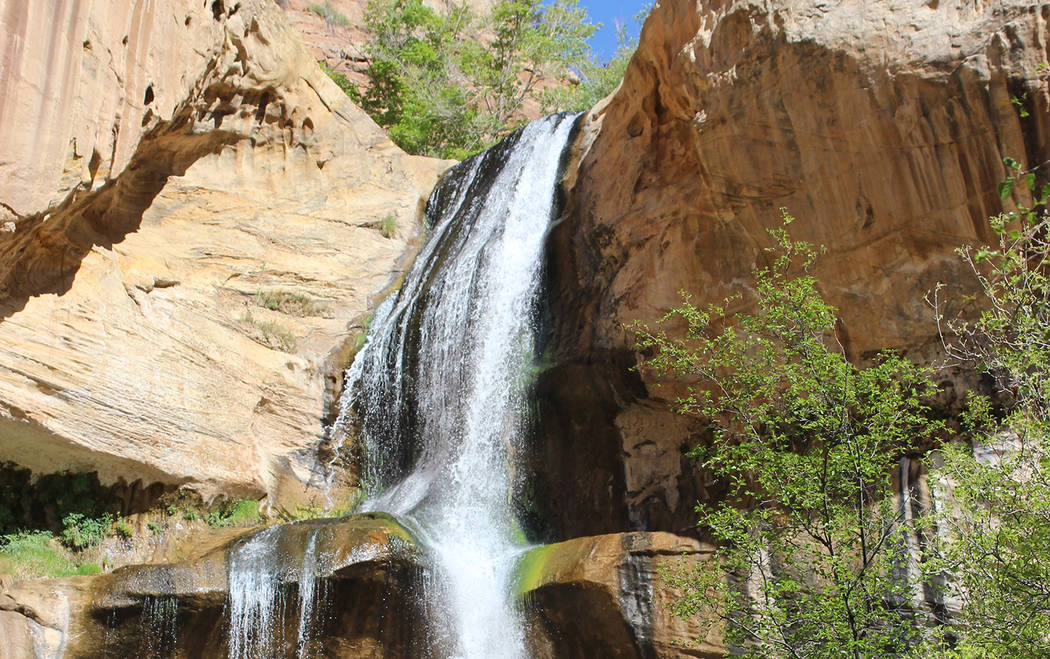
Set within a wide Navajo sandstone canyon in south central Utah is lower Calf Creek Falls, one of the most stunning waterfalls in the state. Though the waterfall is your destination, the hike itself offers incredible scenery including wetlands, beaver dams, prehistoric pictographs and granaries, and beautiful Calf Creek itself.
The trailhead is in the Calf Creek Recreation Area’s campground, at an elevation at 5,346 feet. The hike is 6 miles round trip but only moderately strenuous because it only has a 190-foot elevation gain. It is also a safe hike for any children who can handle the distance.
At the trailhead, so you don’t miss any of the highlights, pick up a trail brochure that gives numbered information sites along the trail. Be sure to start first thing in the morning — dawn is best — to avoid crowds on the narrow trail.
The hike follows along Calf Creek intermittently and in some areas, if you look close, you can see brown, rainbow and brook trout. As you get closer to the falls you might find beaver dams that have formed small ponds and marshy areas that support cattails, reeds and river birch.
Wildlife in Calf Creek Canyon includes mule deer, ground squirrels, porcupines and mountain lions. Birds you might see here include wild turkeys, hummingbirds, spotted towhees, peregrine falcons and robins.
Be sure to bring your binoculars for a better view of the pictographs painted in red pigment on the sandstone cliff face on the far side of the canyon. They appear to be warriors of some sort and are a good representation of Fremont-style rock art.
The ancient Fremont culture inhabited Utah A.D. 700 to A.D. 1300. It is thought that they farmed this canyon. They grew corn, beans and squash and harvested the pinyon pine nuts found in abundance here. You might see the two granaries, found up on the cliffs above the trail, which were used to store food and seeds.
About half a mile before reaching the falls you will hear them, before even seeing them as the trail at this point is canopied by mature deciduous trees, primarily box elder. Once out from under the canopy, though, you’ll encounter a breathtaking view of the waterfall and large pool beneath. On the cliffs beside the waterfall you will see water-loving plants growing from nooks and crannies. Look for maidenhair fern, scarlet monkey flower and Easter flower.
Plan on a half day to hike to the falls and back and at least two nights in the area for camping or lodging in Escalante or Boulder, Utah. Calf Creek Campground has 13 campsites and is managed by the Bureau of Land Management. Dispersed camping is allowed in many parts of the area with a free permit.
Average daily high temperatures in May are in the high 70s and low 80s with lows in the 40s. Wear hiking shoes, a hat and sunscreen, bring food and carry a gallon of water per person. Bring a bathing suit or quick-drying clothes and quick-dry towel for wading or swimming under the falls. If you have water sandals such as Chaco or Teva type, they will come in handy in the creek and at the waterfall.
For more information, contact the Escalante Visitor Center, 755 W. Main St., Escalante, Utah, call 435-826-5499 or visit http://www.ut.blm.gov/monument.
The visitor center is open from 8 a.m. to 4:30 p.m. daily.
Many of Deborah Wall’s columns have been compiled into books about hiking in the Southwest. She is also the author of “Great Hikes, a Cerca Country Guide” and a co-author of the book “Access For All, Seeing the Southwest With Limited Mobility.” Wall can be reached at Deborabus@aol.com.